Papers by Anna Materiienko

Klìnìčna farmacìâ, 2017
При одночасному прийомі антибіотиків групи тетрацикліну з компонентами їжі та напоїв може знижува... more При одночасному прийомі антибіотиків групи тетрацикліну з компонентами їжі та напоїв може знижуватись біодоступність, ефективність препарату, змінюватись кінетика його вивільнення. Яскравим прикладом є взаємодія доксицикліну з антацидними препаратами, харчовими продуктами, що містять катіони лужноземельних металів, такими як молоко, сир та іншими. Проте експериментальні дані щодо можливої взаємодії доксицикліну з мінеральними водами та безалкогольними газованими напоями відсутні. Тому метою статті є вивчення можливої взаємодії доксицикліну з солями лужноземельних металів та її впливу на біодоступність в експерименті in vitro. Матеріали та методи. Об'єкти дослідження-капсули доксицикліну хіклату, мінеральні води та напої. В ході дослідження використовували аналітичні ваги Mettler Toledo AB-204/A. Тест «Розчинення» для твердих лікарських форм проводили на приладі PharmaTest-DT70 (Німеччина). Кількісний вміст діючої речовини визначали на спектрофотометрі «Specord 200» (Німеччина). Результати. Встановлено збільшення концентрації доксицикліну у середовищі 0,1 М розчину HCl із додаванням мінеральних вод: «Карпатська джерельна», «Трускавецька», «Єсентуки № 17», «Поляна квасова», а при додаванні напою «Спрайт» спостерігається зниження концентрації порівняно із контрольним зразком. Профіль розчинення капсул доксицикліну у середовищі 0,1 М HCl із додаванням мінеральної води «Трускавецька» не є подібним у порівнянні із контрольним зразком. Профілі розчинення інших досліджуваних мінеральних вод та «Спрайту» є подібними. Висновки. Можна зробити припущення щодо можливої взаємодії катіонів кальцію та магнію, наявних у вищезазначених водах, із молекулою доксицикліну хіклату. В практичному сенсі це означає недопустимість одночасного прийому досліджуваних мінеральних вод із капсулами доксицикліну хіклату. Ключові слова: доксицикліну капсули; профіль розчинення; катіони металів; комплекси; взаємодія з мінеральними водами

The aim: A novel comparative analysis of the secoiridoid glycosides composition in Centaurium ery... more The aim: A novel comparative analysis of the secoiridoid glycosides composition in Centaurium erythraea Rafn. and Cеntaurium pulchellum (Sw.) Druce has being described. Swertiamarin has been chosen as an active marker and its comparative quantitative estimation in two species of the raw material has been carried out by HPLC method. Materials and methods: The quantitative HPLC analysis of swertiamarin was conducted using a chromatographic column ACE 5 C18. Methanol and 0,5 % acetic acid aqueous solution were used as mobile phases; the chromatographic procedure was carried out in a gradient mode. Results: The content of swertiamarin in the C. pulchellum herb ranges from 2.51 to 3.07 mg/100 mg. In that time swertiamarin content in C. erythraea herb varies and depends from 3.83 to 8.94 mg/100 mg. The content of swertiamarin in C. pulchellum herb is much lower than in C. erythraea herb. Taking into account this fact the possibility of using of C. pulchellum herb for medicine in...
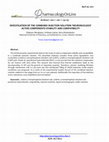
The article presents experimental data on the study of active components stability and compatibil... more The article presents experimental data on the study of active components stability and compatibility in a combined injection solution. The described medicine contains three active ingredients: two nucleotides (uridine-5-monophosphate disodium salt (UMP), cytidine-5-monophosphate disodium salt (CMP) and vitamin B6 (pyridoxine hydrochloride) (PHC). It was proved that the medicine components do not interact with each other. The research also showed that thermal sterilization leads to the decomposition of API and the growth of impurities quantity. Therefore, solution sterilizing filtration through membranes with 0.2 μm pore size and subsequent filling of sterile ampoules under aseptic conditions was proposed. As a result of the experimental studies the pH of the combined injection solution medium in the range from 4.0 to 5.0 was selected. Additionally the impurities of the medicine active substances were established and normalized.
Ceska a Slovenska farmacie : casopis Ceske farmaceuticke spolecnosti a Slovenske farmaceuticke spolecnosti
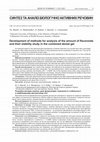
News of Pharmacy, 2021
An important aspect in the pharmaceutical development of dental medicines is to provide them with... more An important aspect in the pharmaceutical development of dental medicines is to provide them with a prolonged therapeutic effect while reducing the side effects of drug substances and the possibility of long-term use. This can be achieved by using active components of plant origin. Aim. To develop methods for analyzing biologically active substances in the composition of a new combined dental gel. Materials and methods. The study object was a dental gel containing “Phytodent” complex tincture (PJSC “CPP Chervona zirka”, Ukraine). Based on the analysis of the composition of the tincture it was proposed to carry out standardization by the amount of biologically active substances, namely flavonoids. Identification was carried out by TLC, while the quantitative determination by absorption spectrophotometry, the ultraviolet and visible method by the reaction with aluminum chloride using the standard method calculated with reference to rutin and the absorbance measurement at 406 nm. Resul...

Research Journal of Pharmacy and Technology, 2021
1-(4-methoxyphenyl)-5-[2-[4-(4-methoxyphenyl)piperazin-1-yl]-2-oxo-ethyl]pyrazolo[3,4-d]pyrimidin... more 1-(4-methoxyphenyl)-5-[2-[4-(4-methoxyphenyl)piperazin-1-yl]-2-oxo-ethyl]pyrazolo[3,4-d]pyrimidin-4-one has been reported as a promising new anticonvulsant drug candidate with a code name “Epimidin”. A new HPLC method for the related substances determination of potential active pharmaceutical ingredient has been developed and validated. The method uses ACE C18 column (250x4.6mm, 5µm) and gradient elution. Mobile phase consisted of a mixture of methanol R (mobile phase A) and phosphate buffer solution with triethanolamine, adjusted to pH 7.0 (mobile phase B). During the analysis, the ratio of mobile phases was changing according to a gradient mode at a flow rate of 1ml/min. The DAD detection was set at 240nm. The method was validated according to the ICH guidelines and requirements of State Pharmacopoeia of Ukraine. Drug substance was thoroughly explored for stability assessments under various stress conditions such as high temperature, as well as the influence of strong acid and bas...
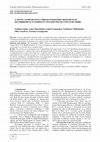
The aim: A novel comparative analysis of the secoiridoid glycosides composition in Centaurium ery... more The aim: A novel comparative analysis of the secoiridoid glycosides composition in Centaurium erythraea Rafn. and Cеntaurium pulchellum (Sw.) Druce has being described. Swertiamarin has been chosen as an active marker and its comparative quantitative estimation in two species of the raw material has been carried out by HPLC method. Materials and methods: The quantitative HPLC analysis of swertiamarin was conducted using a chromatographic column ACE 5 C18. Methanol and 0,5 % acetic acid aqueous solution were used as mobile phases; the chromatographic procedure was carried out in a gradient mode. Results: The content of swertiamarin in the C. pulchellum herb ranges from 2.51 to 3.07 mg/100 mg. In that time swertiamarin content in C. erythraea herb varies and depends from 3.83 to 8.94 mg/100 mg. The content of swertiamarin in C. pulchellum herb is much lower than in C. erythraea herb. Taking into account this fact the possibility of using of C. pulchellum herb for medicine instead of C...

Ceska a Slovenska farmacie : casopis Ceske farmaceuticke spolecnosti a Slovenske farmaceuticke spolecnosti, 2020
Medicines containing both a herbal extract and a synthetic substance are in high demand due to th... more Medicines containing both a herbal extract and a synthetic substance are in high demand due to their beneficial effects and synergism. The novel combination of salbutamol sulfate and Hedera helix extracts seems to be prospective in terms of pharmacological activity. But for quality assurance, impurities of the synthetic component have to be determined and quantified. Plant extracts consist of various phytochemical components, therefore, it is more complicated to develop a selective analytical method due to the sample matrix. To prove the safety and efficacy of the dosage form, a new HPLC method for analysis of salbutamol sulfate impurities was developed and validated. The method was used to estimate the safety of the novel syrup by performing long-term stability studies for 24 months. Obtained results indicated the absence in both significant reducing of the main components content and increasing of related substances level. Also, force degradation was carried out to prognosticate t...
Ceska a Slovenska farmacie : casopis Ceske farmaceuticke spolecnosti a Slovenske farmaceuticke spolecnosti, 2018

4 Department of Analytical and Toxicological Chemistry, Lithuanian University of Health Sciences,... more 4 Department of Analytical and Toxicological Chemistry, Lithuanian University of Health Sciences, 13 Sukilėliai Avenue, 50161 Kaunas, Lithuania A new high-performance liquid chromatography (HPLC) method for the simultaneous quantitative determination of active pharmaceutical substances and preservatives in a new dental medication has been developed. The optimization of HPLC method parameters was done through studies of a mobile phase composition and a detection wavelength. Our developing method uses an ACE C18 column (250 × 4.6 mm, 5 μm) and a gradient mode for separation with the acetonitrile and phosphate buffer solution (adjusted to pH 3.0) as mobile phases. The flow rate is 1 ml/ min, and the detection was set at 260 nm (DAD). The method was evaluated according to the ICH guidelines and the State Pharmacopoeia of Ukraine in terms of specificity, accuracy, linearity and precision (repeatability and intermediate precision). The limit of detection and the limit of quantification we...

Carmoisine is the synthetic food dye, which is used in the manufacturing of some medicals and foo... more Carmoisine is the synthetic food dye, which is used in the manufacturing of some medicals and food products. Previously, we had already been established, that it is able to form the ion associates with some organic amines and their salts, including medicinal substances, and it was capable in this form to be extracted from aqueous solution. The aim of our research was studying the properties of formed ion associate between carmoisine and myramistin - quaternary ammonium compound. As the result of the work performed, that absorption spectra of mixture of carmoisine and myramistin was characteristic by bathochromic shift of the aromatic and long wavelength peak maxima in visible area of the initial dye and by hypochromic effect, reflected particularly in the area of the maximum of the dye. The partition coefficients for various solvents ror the associate were spectrophotometrically established and it is shown, that the highest ratio was observed when extraction associate with chlorofor...
4 Department of Clinical Biochemistry, Forensic Toxicology and Pharmacy, Kharkiv Medical Academy ... more 4 Department of Clinical Biochemistry, Forensic Toxicology and Pharmacy, Kharkiv Medical Academy of Post-graduate Education, 58 Amosova Street, 61176 Kharkiv, Ukraine The article presents results of studies on the development of a quantification method for a substance 7-(4-fluorobenzyl)-3-thioxo-2,3-dihydro-[1,2,4]triazolo[4,3-a]pyrazin-8(7H)-one using the method of nonaqueous potentiometric titration. Validation of the developed method has been carried out confirming the following characteristics: linearity, accuracy and precision that match the acceptance criteria for these measures.

Vìsnik farmacìï
Recently different excipients, including colouring agents, are often used to give a marketable ap... more Recently different excipients, including colouring agents, are often used to give a marketable appearance and improve the consumer characteristics of drugs. Usually they are applied in the composition of medicines for internal use (tablets, capsules, syrups, troches, lozenges, etc). Synthetic azo dyes – a group of compounds obtained by the coupling reaction of sulfonaftilamines and diazotised sulfoanilines with aromatic or heterocyclic phenols are the most widely used in the pharmaceutical practice. Compounds of this group give bright, easily reproducible colours, they are resistant to the light, oxidants, reducing agents, pH changes and less sensitive to different types of technological impact. Synthetic azo dyes are poorly absorbed from the intestines after intake, but they can form ion associates with salts of organic bases, including with drugs, and it may alter their bioavailability. The aim of our work was to determine the partition coefficient of the ion associate of a synthetic food azo dye carmoisine with the medicinal substance chlorpheniramine maleate in the water-chloroform system and to study the stoichiometric ratio of the components in this ion associate. The partition coefficient in the water-chloroform system has been determined spectrophotometrically. It is 3.44, indicating that the ion associate is more soluble in water than in chloroform. The stoichiometric ratio of carmoisine and chlorpheniramine maleate in the resulting ion associate has been determined by HPLC, and it is 1:2. In today’s competition producers face the challenge not only to provide consumers with qualitative, effective and safe drugs, but also to defend the competition in its segment of the pharmaceutical market. Various excipients, including food dyes, are widely used to improve the consumer characteristics. In the pharmaceutical industry synthetic azo dyes, in particular carmoisine (E 122), are the most commonly used [6-9]. Carmoisine, a red coloured synthetic food azo dye, is a derivative of diazosulfonaphthalenes, a crystalline substance that is soluble in water [5, 10]. Earlier when developing the method for quantitative determination of carmoisine in the composition of drugs we have found that it is capable to form ion associates with organic amines, particularly with such medicinal substance as chlorpheniramine maleate and to extract with an aqueous solution of chloroform in this form [3, 4]. Chlorpheniramine maleate (3-(4-chlorophenyl)-N,N-dimethyl-3-pyridin-2-yl-propan-1-amine) is the active pharmaceutical ingredient of the synthetic origin. It is a white crystalline powder, easily soluble in water, soluble in ethanol and poorly soluble in diethyl ether. It exhibits the cholinolytic and antihistaminic action [2]. The aim of our research is to calculate the partition coefficient in the water-chloroform system and to study fur ther the ratio of the components in the ion associate formed.

In recent years, the development and implementation of new in vitro techniques for ecotoxicology ... more In recent years, the development and implementation of new in vitro techniques for ecotoxicology and environmental risk assessment has become a priority; however, the current data indicate a lack of standardization in available in vitro sperm tests. In this review, we describe the main approaches currently used for in vitro toxicity testing of fish spermatozoa. Though fish species show huge diversity in their reproductive strategies, most are external fertilizers. Fish spermatozoa are highly specialized, transcriptionally inactive cells that become motile only upon spawning in the aqueous environment. Here, we suggest that they could become a useful toxicology tool because of their simplicity and availability. Indeed, fish spermatozoa are a promising model for genotoxicity testing, since parental exposure to genotoxicants, both in vivo and in vitro, affect embryo development. In aquaculture practice it means that evaluation of spermatozoa DNA damage could help in predicting embryo q...
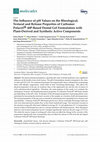
Molecules
The physicochemical properties, especially pH value of dental medicines, have significant influen... more The physicochemical properties, especially pH value of dental medicines, have significant influence on the health of oral cavity tissues. The pH of formulations should correspond to the value of saliva pH (5.5–8.0). For carbomer-based gels, the required pH value is obtained by neutralizing them with alkaline components, which leads to their structuring (thickening). This affects the physical properties of the gel, its residence time at the application site and the rate of release of active pharmaceutical ingredient. Therefore, the main purpose of this study is to evaluate the rheological, textural, and biopharmaceutical properties of Carbomer Polacril® 40P-based dental gel depending on the pH value. Evaluation of the rheological properties of gel preparations were performed by measuring the structural viscosity of the samples as a function of pH and temperature. The textural properties of the gel were evaluated by performing tests regarding back extrusion and spreadability. Carbomer...
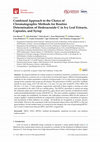
Scientia Pharmaceutica
Developed methods for routine analysis of medicines should be considered in terms of analytical e... more Developed methods for routine analysis of medicines should be considered in terms of analytical efficiency, economic cost, as well as their environmental impact. Different chromatographic methods for the routine quantitative analysis of hederacoside C in ivy leaf extract and its original dosage forms (capsules and syrup) are developed. The performance of HPLC and UPLC methods should be done using ACE C18 (150 mm × 4.6 mm, 5.0 μm) and ACQUITY UPLC BEH C18 (50 mm × 2.1 mm, 1.7 μm) columns, respectively, and both of them require a mixture of water and acetonitrile in the ratio 71/29 as a mobile phase. The HPTLC procedure is carried out using the stationary phase pre-coated silica gel 60 F254 glass sheets and a mixture of anhydrous formic acid/acetone/methanol/ethyl acetate (4:20:20:30 v/v). The most suitable conditions of preparation for each sample are established, for instance, the solid-phase extraction (SPE) for the analysis of syrup is applied. Analytical methods are compered by a...
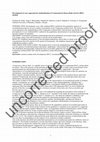
Turkish Journal of Pharmaceutical Sciences
INTRODUCTION: Development a new, fully validated HPLC method for the quantitative analysis of sec... more INTRODUCTION: Development a new, fully validated HPLC method for the quantitative analysis of secoiridoid glycosides by an active marker swertiamarin in the Centaurium erythraea herb. The article describes a new approach to the standardization of the Centaurium erythraea Rafn. herb and more specifically the development of a new validated HPLC method for the quantitative determination of secoiridoid glycosides by the active marker swertiamarin. METHODS: Swertiamarin quantitative determination has been estimated in an isocratic mode, on a Symmetry C18 column, using water and acetonitrile as solvents for the mobile phase. RESULTS: Validation characteristics of the developed method have shown that it is linear in the whole range of concentrations from 0.01 mg/ml to 0.05 mg/ml of swertiamarin. All validation characteristics meet the established acceptance criteria. DISCUSSION AND CONCLUSION: This method can be used in the standardization of raw materials, as well as in the analysis of medicinal products and dietary supplements, which include the Centaurium erythraea herb. The established chromatographic method has been successfully applied for the analysis of raw materials of the Centaurium erythraea Rafn. herb with the quantitative content determination of swertiamarin in the analyzed samples.





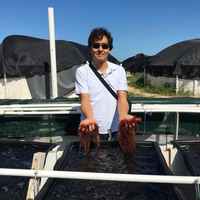





Uploads
Papers by Anna Materiienko